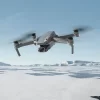Top 5 Best Drones Under $1000
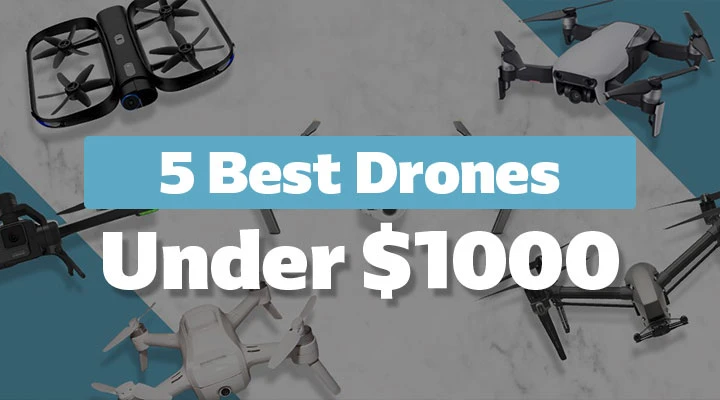
Looking for the best drone under $1000?
Well, you’ll be glad to know that the price range between $500 and $1000 has arguably the best overall drones the market offers.
Sure, you could easily spend $10k+ on the top-of-the-line drones the market has, but is it worth spending thousands of dollars more to have a few more upgraded specs? In our opinion, probably not, and unless you need the absolute best for a very specific purpose, we recommend staying in the 500-1000 dollars range for the best bang for your buck.
If you want to buy a drone for a hobby, for your trips, or you have a business that may use drones to optimize daily tasks, one of these top picks will definitely be ideal for your needs. Quadcopters of $1000 or less have exceptional cameras and great specs and are some of the most advanced machines on the market.
Let’s go over our top picks for the best drones under $1000. Buckle down and keep reading.
DJI Mini 3 Pro (Best Drone Overall Under $1000)
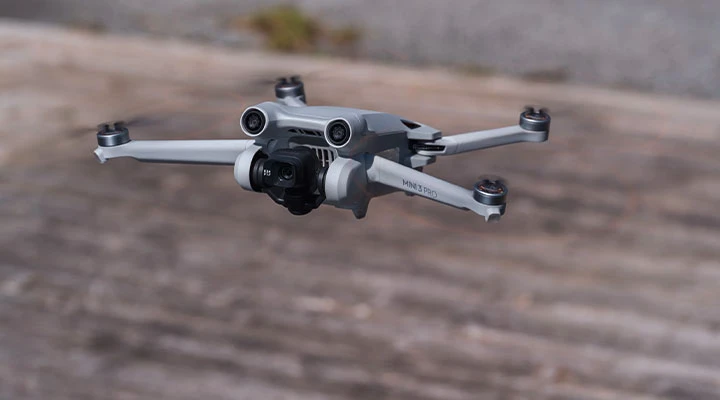
The tiny and lightweight DJI Mini 3 Pro takes DJI‘s popular mini drone series to new heights. The new Mini 3 brings the ‘wow’ factor to the sub-250g category.
Specifications
| Price | $459 |
| Camera resolution | 12MP/4K60 |
| Battery | 34 minutes with a full charge |
| Weight | 249g |
| Dimensions | 14,5x9x6,2cm (folded) |
| Price | $829 |
What’s most impressive about this newcomer drone is that DJI has managed to include a tri-dimensional obstacle avoidance system inside such a small drone, and that’s not even the most mind-boggling improvement over its predecessors. The Mini 3’s sensor is bigger and is now a 1/1.3-inch CMOS chip. Its lens’s maximum aperture has been improved to a bright f/1.7, and its video capabilities have been vastly increased too. The video camera boasts a 4K resolution at up to 60FPS, 2,7K60FPS, and 1080p up to 120FPS. The camera can also be rotated 90 degrees, enabling you to capture stills and video in both landscape and portrait format.
The list of improvements doesn’t stop here, though, as there’s much more to the Mini 3 Pro.
One of the critical aspects of the Mini 3 is that while being so powerful in the specs department, it still weighs 250g, which means it doesn’t need to be registered in most countries. These features, along with the new DJI RC Smart controller that’s available in the priciest option of the Mini 3, make this drone a tempting option for aerial content creators.
The only downside to the Mini 3 Pro is the increased price relative to its predecessor. However, this price leap is to be expected if you factor in all the specs and key features this quadcopter provides.
The DJI Mini 3 Pro is a serious upgrade for the Mini series and the best compact drone you can buy right now. With its large sensor, built-in obstacle avoidance, and intelligent flight modes, it packs the performance of larger and more expensive drones into a compact and convenient package. Even though the Mini 3 Pro is catered towards beginners, its price tag lifts it to a more seasoned and exclusive audience.
Read our in-depth DJI Mini 3 Pro review here
Pros
- Staggering camera performance
- Useful obstacle avoidance system
- Easy to fly
- Weighs less than 250g
Cons
- A bit expensive
DJI Air 2S (Best Camera Drone)
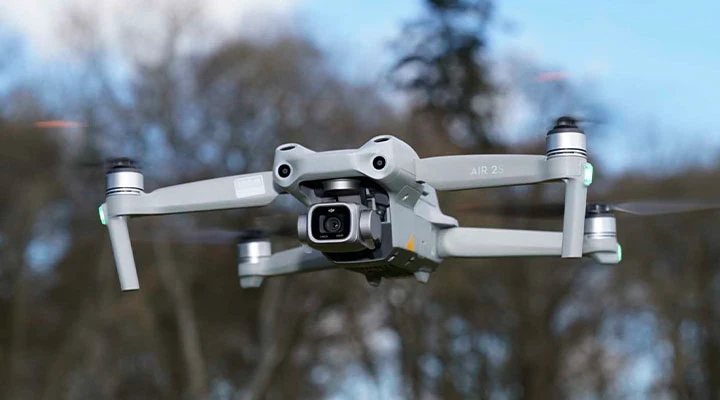
This quadcopter is another close contender for the best drone under $1000, and despite the arrival of the newer Mini 3 Pro, the Air 2S remains arguably the best camera drone in that price range.
Specifications
| Camera resolution | $20MP/5.4K30 |
| Battery | 31 minutes with a full charge |
| Weight | 595g |
| Dimensions | 18×9,7×7,7cm (folded) |
| Price | $799 |
While the name of the quadcopter suggests that it’s only a mere upgrade of the older Mavic Air 2, there are a lot of staggering upgrades in this drone, most importantly, a 1-inch sensor that lets you take breath-taking footage.
The Air 2S sports a 20MP 1-inch sensor, which improves image quality and provides an improved high ISO response compared to the Air 2. For videos, it can shoot 5.4K video at 30 FPS, 4K videos at up to 60fps, and 1080p at up to 120 FPS, which opens up the significant creative potential for capturing video.
Another feature hyped up is the Air 2S’s digital zoom, which starts at 4X with 4K30FPS video and goes up to 8X zoom with 1080p. This feature may not sound as exciting as the rest, but maintaining a safe distance can be crucial if you factor in how many restrictions there are that don’t allow you to get too close to certain objects or people. This can be an essential feature, especially for professional drone pilots, and for enthusiasts, it will open the doors to more staggering footage of their trips.
Image quality is superb, as you would expect from a camera lens of this caliber and the noise levels at high ISO settings are much better than Air 2S’s predecessors. Yet, images are slightly softer at the edges, and the aperture is fixed at f/2.8, so the only way to control exposure during video recording is by using filters.
Still, we think the DJI Air 2S is one of the best drones overall for most people, especially if the camera is your focus. This quadcopter is hard to beat thanks to its combination of a large 1-inch sensor and compact, travel-friendly dimensions.
Read our in-depth DJI Air 2S review here
Pros
- One of the best cameras in this price range
- Small and lightweight
- Easy to use and fly
Cons
- No adjustable aperture
- Weighs over 250g
- Image edges are slightly softer
DJI Mini 2 (Best Budget Drone)
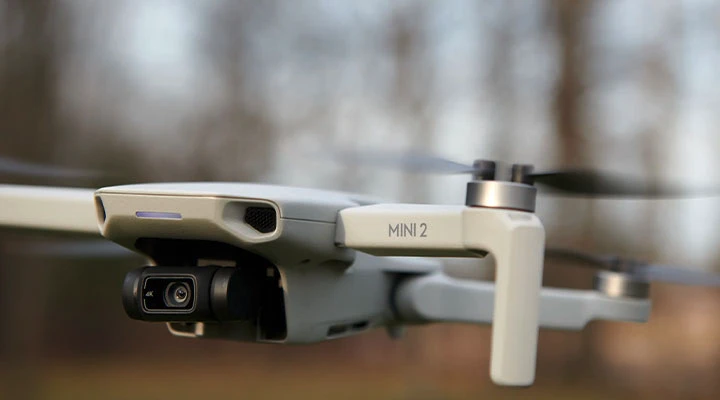
The Mini 2 hardly stands a chance if we compare it to the previous two drones. However, the DJI Mini 2 is almost unbeatable from a price standpoint.
Specifications
| Camera resolution | 12MP/4K30 |
| Battery | 31 minutes with a full charge |
| Weight | 249g |
| Dimensions | 13,1×8,1×5,8cm (folded) |
| Price | $459 |
It’s an ultra-compact drone that’s so small and easy to use that you can slip it out of a backpack and launch it within seconds. It’s been succeeded by the Mini 3 Pro but remains one of the best affordable alternatives on the market today. The price tag of the Mini 2 also makes it the best beginner drone for those who want to have a great camera at a budget price.
Mini 2’s design is basically identical to that of the Mavic Mini, but the controller has been revamped, which is now sturdier and delivers a boosted flying experience compared to its predecessor. The Mini 2 is foldable with arms that fold in to transform into a truly palm-sized machine.
One good thing about this drone is that it weighs 249g, so it doesn’t require a registration to be used, but the lightweight is maybe the least impressive feature of this machine. The DJI Fly app is also a well-balanced combination of simple to use but with handy features for both pros and newcomers. Casual drone flyers won’t need to venture too much into these modes, but there’s plenty to master if you want to.
DJI is known for its stabilization features, and the Mini 2 delivers a fantastic, exceptionally stable flight experience.
The Mini 2’s video capabilities are incredible, and the video is rock-steady even in the windiest conditions, which is impressive for such a small drone. Even with level 5 winds, taking stable and crisp-clear videos was child’s play for this machine.
Unedited footage can look flat and overexposed, but it’s clear that DJI processes footage cautiously and with video editors in mind. Digital zooming is limited to 2X if you’re shooting in 4K, but you can get to 3X for 1080p footage. Mini 2’s camera performance in low light isn’t that good, though, and as soon as the light drops, so does the usable zoom range.
Lastly, the battery is solid, with around 30 minutes of flight time on a single battery charge while shooting mixed 1080p and 4K resolution videos.
The DJI Mini 2 is the perfect entry-level drone for beginners also looking for a fantastic camera to capture beautiful landscapes and cityscapes. It offers a staggering 4K resolution camera despite its small sensor size, however, it lacks an obstacle avoidance sensor, which can be an issue for newcomers.
Pros
- Compact and light drone
- Great battery
- Cheap
Cons
- Camera isn’t great in low-light conditions
- No follow-me mode
Autel Evo Nano+ (Best DJI Alternative)
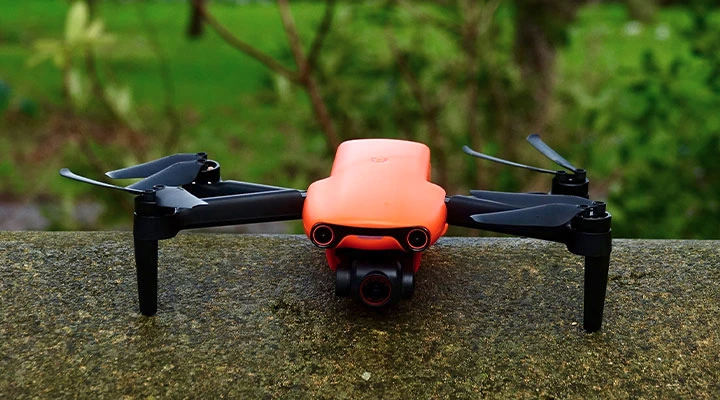
Autel has always been one of the best DJI alternatives on the drone market. It had some success with the EVO II, but it took its newer machine to really convince drone fans that it could take the market leader with an innovative quadcopter.
Specifications
| Camera resolution | 12MP/4K30 |
| Battery | 28 minutes with a full charge |
| Weight | 249g |
| Dimensions | 14,2×9,4,5,5cm (folded) |
| Price | $798 |
The Evo is an excellent drone for beginners in the sub-249 category and has very similar ergonomics to the Mini 2, making the Nano+ super light and portable. One of the things that makes the Evo different from the DJI series is its design. The Nano+ design isn’t stripped-down like its competitors.
Also, the Nano+ includes obstacle avoidance sensors, a great 1/1.28-inch sensor for capturing 4K video in low light conditions, and up to 48MP still images. The camera of the Evo is excellent, as it uses a pretty large sensor and has an aperture of f/1.9 that allows more photons to hit the sensor. The available ISO range is 100 to 6400 ISO too.
Photos and video are stunning for a mini drone of this caliber and price tag, and with a few exceptions (DJI Mini 3 Pro), the Autel is capable of better image and video quality than any other lightweight drone. The maximum video resolution is 4K30FPS at a bitrate of 100Mbps. The camera sensor is technically a 12MP one but can go up to 48MP with some interpolation involved.
Battery life is decent, with 28 minutes of total flight time with a fully charged battery, but you can get the premium bundle with additional batteries to take the total flight time up to 84 minutes. Video transmission distance isn’t bad at all, with a maximum range of 10km with the Autel Skylink technology.
On top of that, if you are a beginner and find it stressful to manually avoid obstacles, buildings, and tree branches, the Autel offers a three-way obstacle avoidance allowing it to detect structures in the front, behind, and below the machine, while flying in Smooth or standard mode. The obstacle avoidance system is image-based, which means that it doesn’t work at all in low light or at night.
The Autel comes in a variety of colors, too, offering orange, white, gray, and red.
Autel’s latest creation was so close to success but also so far away at the same time. The company tries every year to compete with DJI’s flagship models, but it still hasn’t arrived at that point yet due to issues with the software and other shortcomings. However, if you want to try something different other than DJI, the Autel is arguably the best DJI alternative model on the market.
Pros
- Big sensor
- Collision detection/li>
- Amazing videos and photos
- Weighs under 250g
Cons
- Fragile
- No subject tracking
- Controller is pretty bad
Parrot Anafi (Another Great DJI Alternative)
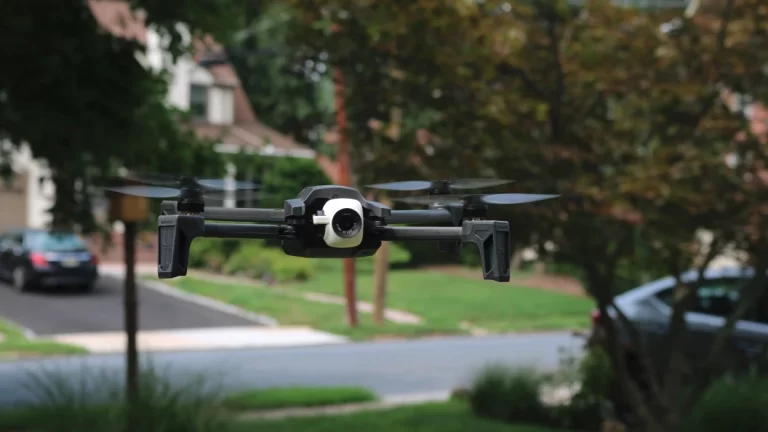
When the Parrot Anafi launched, its motto was pretty simple: They will match DJI‘s specs you’re used to for a lower price.
Specifications
| Camera resolution | 21MP/4K UHD 30 |
| Battery | 23 minutes with a full charge |
| Weight | 320g |
| Dimensions | 24,4×6,7×6,5cm (folded) |
| Price | $450 |
Easier said than done, but the Parrot company may be up for something with their most popular quadcopter. The Anafi is an easy-to-use drone for beginners but offers features and functionalities you’ll naturally desire as your skills and confidence grow as well. So, while not the cheapest drone on this list, it’s undoubtedly of the best models you can find on the market for under $1000.
Parrot’s drone is small and lightweight, but at a weight of 320g, it requires registration to fly. It also sports automated flight patterns to make capturing professional-looking photos and videos a piece of cake.
One big issue the Anafi has is the lack of anti-collision systems, so if you’re a newcomer, you must be careful when flying this quadcopter. Flying the Anafi is a pleasure though, and with the Sky Controller 3, the intuitive app, and the excellent stabilization, you have enough “help” to make you an expert drone pilot in no more than a few minutes. The Anafi also has a Return To Home button at the center of the controller, which is always a great perk, especially for beginners who may have issues landing the drone their first few tries.
The camera on this machine is cable of shooting high-quality footage thanks to the 21MP sensor and the ability to shoot videos up to 4K. There’s a digital zoom option of up to 2.8X and a standard zoom option of 3X. Video settings are much more limited to what DJI offers, but you get the bare-bones options with the Anafi.
This thin, bug-like drone is an excellent choice for flight experts and filmmakers too. Its incredible vertical range camera capture 4K UHD films and 21MP photos, and on top of that also sports a fantastic zoom option. Its lightweight, slim frame also won’t take up much room in your hand.
Pros
- 4K UHD video at 30FPS
- 21MP camera
- Slim but sturdy frame
Cons
- No obstacle avoidance system
- Small battery
- Very few video modes
Final Words
With so many great drones on the market, it might be a herculean task to choose the best one for under $1000. Most quadcopters fall under that price range, and you’ll find arguably the best bang for your buck drones in the sub-$1000 price range.
The final advice would be to look at your needs and decide accordingly. In our opinion, the DJI Mini 3 Pro is overall the best drone you can ask for in that price range. However, it isn’t objectively the best sub-$1000 drone on the market. If you need the best camera your money can possibly get with that budget, the best solution for you would be the DJI Air 2S.


